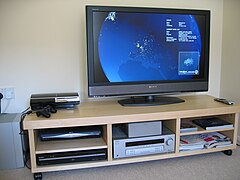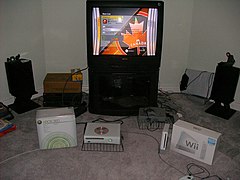History of video games/Consoles
The First Generation of Video Game Consoles
[edit | edit source]Home game consoles as they are known today have to start somewhere and this is it. Though there are a number of definitions of which generation a console belongs to from here on out, most at least agree that the home consoles here belong to the first generation. After this definitions quickly get out of sync with each other Keep in mind that people classify game console generations as more of an art than a science, and there is no formal industry or academic organization which classifies consoles by their generation. While console generations are arbitrary, they still help with understanding consoles historically, so this book uses them.
Going forward in this book this book will generally share its console classification system with the system used by Wikipedia. This is because the system used by Wikipedia is widely used casually by the general public and news outlets. However it's important to note that this system is by no means the only one, and it definitely isn't the correct one in many academic contexts. As stated previously, console generations are fairly arbitrary. However they aren't entirely baseless either. Besides time of release, generations are typically classified using factors such as the technologies used, social factors, economic conditions, and other influences. When a generation is mentioned in this book, prevailing industry movements will be brought up under Trends. Though these are not always universally true for a generation, they help give a big picture impression of what the industry valued at the time, and how things were changing.
The Bare Minimum
[edit | edit source]As an emerging technology, designers struggled to simply make an interactive device that plugs into a television, let alone design complex games for them. Systems this generation are often capable of drawing just a few lines or dots on a television screen, and little more. Systems often made more with less by asking players to attach overlays to their television sets, and other tricks to make the most out of limited hardware capabilities.
Features many would consider fundamental today, such as automatically keeping scores, are not a given and are frequently left for the player to keep track of. Other features such as color graphics, single player modes, and the ability for a console to generate even a simple beep for audio were sometimes included, but were by no means universal. Keep in mind that this console generation started less than two decades after the first consumer color television broadcast.[1] In fact, in 1972, when the Magnavox Odyssey kicked off the first generation of home video game consoles, Color Television adoption had only just reached over 50% in the United States of America,[2] and many important nations had yet to launch color TV broadcasts.[3]
Dedicated systems
[edit | edit source]Most first generation consoles were only able to play the games built into them, with the Magnavox Odyssey being the primary semi-exception by using jumper cards used to manipulate console internals for desired results.[4] Other consoles such as those in the PC-50x family, were simply adapters for cartridges which effectively contained the entire console. Proper cartridges used as game software media would not appear until the second generation with the Fairchild Channel F.[5]
Late in this generation, the industry also saw the first TV-Game console combination unit, in the 1977 ITT Schaub-Lorenz Programmable Television.[6][7] This trend of integrating consoles and displays would continue in following generations as a niche market.
Battery power
[edit | edit source]Most home game consoles this generation were powered by batteries, despite needing a television to play games. This reduced the upfront cost and complexity of the system because an AC adapter was not needed and consistent DC power would be supplied by the batteries. Some consoles did have an optional power adapter available for purchase.[8]
It is important to note that during the 1970's power supply technology was undergoing rapid advancements, and efficient switching power supplies were only starting to see adoption in consumer products by the end of the decade.[9]
Home Consoles
[edit | edit source]There were a staggering number of console in the first generation with over 900 models of them sold across the globe.[10] What's even more staggering is that most of them were based on standardized "pong on a chip" designs,[10] playing almost the exact same games as a result. Furthermore, the gaming industry is notoriously bad at preserving its history, and many of these consoles are known by little more than their names. Therefore this part of the book lists only the most notable among these multitude of consoles, for which substantial references still exist.
The Second Generation of Video Game Consoles
[edit | edit source]Flooded Market
[edit | edit source]A huge number of consoles and video games flooded the market. Many of these consoles and games were low quality, and made it difficult for consoles offering innovative features or quality games to compete. This was one factor which lead to the video game crash of 1983.[11]
Digital programmable computers
[edit | edit source]This generation, many game consoles contained basic 8-bit computers. Rarely 4-bit and 16-bit computers would be used, like in the Game & Watch platform (4-bit)[12] or the Intellivision (16-bit),[13] though this had minimal impact on console graphics which were primarily constrained by other factors. Cartridge based systems became normal during this generation, and the introduction of digital programmable computers allowed game consoles to run software, which permitted more varied games than what the console designers originally intended.
Representative Graphics
[edit | edit source]This generation saw increased graphical capabilities of home game consoles, leading to less reliance on simple squares and rectangles in conjunction with overlays, and evolving to simple pixel artwork and rarely vector art. The pivotal choice between industry support for raster or vector graphics technology would hugely affect the industry going forward, with many genres of games favoring one or the other. The ultimate success of the use of raster graphics this generation would lead to their dominant use until the fifth generation of consoles. While these graphics would quickly be considered quite outdated by the mid to late 1980's, this step was a huge leap in quality and allowed more arcade style games to be played on home consoles.
This generation saw the first handheld consoles with basic screens. The displays were typically not visible in the dark and were monochrome only, but they still offered an improvement over the previous approach of using a few basic single color lights as output.
The Third Generation of Video Game Consoles
[edit | edit source]Improved hardware
[edit | edit source]By this point home console graphics became more capable, and were able to more easily represent characters and believable locations with colorful 2D graphics. Music began to take a bigger role in home game consoles.While consoles were still limited in their audio capabilities, many classic game soundtracks have their origins in this generation.
By this point, most home consoles contained most of their computer hardware in the console itself rather than in the cartridges, allowing for cheaper cartridges to be made. This freed up resources to either make cheaper cartridges, or to place enhancements in cartridges such as specialty chips that enhanced features such as audio. This generation also saw increased adoption of save game functionality, which was typically achieved with battery backed RAM located on the cartridge. Still, many games required gamers to save their progress by writing down a password which indicated their progress, and then re entering it when loading the game, which was a tedious endeavor.
VHS consoles
[edit | edit source]A few companies attempted to leverage the audio visual capabilities of Video Home System (VHS) analog cassettes to improve the gaming experience, though no VHS consoles saw huge levels of success. By the fourth generation, companies pursing the same strategy would elect for the digital focused CD-ROM drives instead, though it would take till the fifth generation to see successful game consoles capable of full motion video.
Fourth generation of video game consoles
[edit | edit source]Improved hardware
[edit | edit source]
During this generation pixel art in games becomes more much more advanced, often adopting the pointillism art style to the medium to great effect.[14][15] Sprite based 2D graphics were essentially a solved problem by this generation, which lead to companies to look for ways to differentiate their graphics.
Game consoles also began using pre-rendered 3D Graphics and graphical techniques to give the impression of real 3D graphics running on hardware.[16] Games using simple real time 3D polygons became popular, though they often required enhancement chips to draw just a few hundred polygons a second.[17][18]
This generation audio improved drastically, with much more advanced audio systems.[19][20]
CD capable consoles
[edit | edit source]This generation some companies attempted to release high end consoles with built in CD support, while others tried to launch CD add ons. Both strategies saw lukewarm adoption at best. CD-ROM technology was appealing because they could be used to add recorded video to games, recorded soundtracks, and other features. Furthermore, a high capacity CD-ROM was much cheaper to make ($2 for disk and packaging in 1993) compared to cartridges which held far less and cost far more.[21] As a result CD based games saved significant amounts of money for developers.
Yet CD-ROMs in consoles were not a fully ready technology this generation. Game Developers often used the extra space for enhanced graphics or audio, but often did not use the extra space to further gameplay in a way that could not be done on a cartridge. CD-ROM drives were still quite expensive, despite rapidly declining prices. They were also quite slow compared to cartridges, with long loading times compared to the near instant access allowed by a cartridge.
Fifth generation of video game consoles
[edit | edit source]3D Gaming
[edit | edit source]
Polygonal 3D gaming was supported by all major home consoles this generation. However real time 3D graphics on consumer level hardware was still a new concept, and there were many different wildly different approaches to how a 3D system should work in a console. This lead to some consoles being much better at 3D graphics performance and ease of use by developers, and some with performance much less than their at the time impressive specifications would indicate.
Many game series failed to make effective 3D versions of their traditionally 2D games.[22] Crafting a believable 3D environment on the hardware available was difficult. Furthermore, developers not only had to design good controls for a 3D game, they had to explain them to players used to playing 2D games exclusively.[23] All these issues were exasperated by a lack of developers familiar with 3D gaming, even within major development companies.[24] Even developers that were able to competently make 3D games struggled somewhat, with large improvements in 3D game control schemes occurring within the generation as developers figured out ways to improve the player experience.[25][23]
Display technology
[edit | edit source]
Display technology improves rapidly during this time with the final major refinements in CRT displays, and the emergence of new technologies. In 1996 Sonys Trinitron (Aperture grille CRT) patents expire, allowing other manufacturers to produce similar quality television sets[26][27] and improving the gaming experience. In 1998 Phillips introduces the first consumer plasma TV for $15,000.[28] Such TVs would become common in the mid 2000's with improving technology and price drops.
This generation more portable consoles adopted color screens, though monochrome screens were still common.
Sixth Generation of Video Game Consoles
[edit | edit source]Home console improvements
[edit | edit source]
This generation sees home consoles with enough power to render decent 3D graphics in real time in a variety of realistic and cartoony styles. Furthermore, the common use of optical media and audio compression allows home consoles to regularly play orchestral soundtracks, and enhance narration and immersion with rich voice acting.
Consoles in this generation had to contend with a changing living room, with the beginning of semi-common adoption of flat screen televisions in consumer households this generation.[29] Major consoles attempted to add DVD playback, higher resolution output, or other multimedia features to take advantage of these improved displays.[30][31]
This generation was the first to make online play a serious option, though it would not truly take off across all major platforms till the seventh generation.[30][31]
Handheld improvements
[edit | edit source]Sixth generation handheld game consoles generally have enough horsepower to match fourth generation home console graphics and audio.[32] Some talented developers on lower spec systems and developers for high end handhelds are able to achieve 3D graphics comparable to early fifth generation home console games - an impressive feat at the time.[33]
Many higher end handhelds begin offering efficiently lit color displays, allowing these systems to finally be played in the dark without too huge of a battery life trade off. Furthermore, many high end handhelds also offer built in rechargeable batteries, allowing for more economical long term ownership of such devices. At the start of the generation rechargeable AA batteries were rapidly growing their previously small marketshare,[34] allowing for those on handhelds without internal batteries to effectively have rechargeable systems.
Seventh generation of video game consoles
[edit | edit source]Home Consoles
[edit | edit source]A common occurrence early on in the generation was for gamers to acquire both an Xbox 360 and a Wii.[35][36] This phenomenon was commonly called the Wii60 effect.
The Xbox 360 and the PlayStation 3 both supported HD outputs, but often rendered games below 720p internally, then upscaled to match the output resolution.[37] Many games used bloom and other graphical techniques in a way that created games had washed out and drab colors.[38]
The three major home consoles of this generation each attempted to launch a motion control scheme, to varying degrees of success.[39][40][41]
As systems became more linked to gamers personal data, incidents of personal information exposure often occurred when hapless consumers sold their used systems without first wiping their data.[42]
-
A shop selling HD televisions in 2007, a large improvement over the older SD displays.
-
A typical 2008 home theater setup, featuring an LCD display and a PlayStation 3 running Folding@Home.
-
Another fairly typical home theater in 2009, featuring a "large" screen on a rear-projection HD television.
-
An example of the Wii60 effect.
Handhelds
[edit | edit source]Handheld consoles commonly adopted built in rechargeable batteries by this generation, though some gamers still preferred swappable standardized batteries.[43]
Major handhelds commonly featured graphics comparable to home consoles of the fifth generation.[44][45] This made portable 3D gaming common.
Higher end handhelds adopted Wi-Fi and other wireless communication standards.
Eighth generation of video game consoles
[edit | edit source]HD Rendering
[edit | edit source]This generation saw more games rendered at 720p or higher resolutions, compared to the previous generation, which often upscaled from sub HD resolutions.[46]
To increase performance, many developers resorted to duplicating assets multiple times, which helps during seek operations on rotational media at the cost of ballooning game sizes.[47]
Major handheld consoles generally attempted to match the graphical capabilities of home consoles from the sixth or seventh generations.[48][49][50]
Improved online
[edit | edit source]This generation saw the home consoles ease restrictions on cross platform play, allowing people on different consoles to compete when playing the same games with multiple versions across console and PC.[51][52]
Many Eighth generation home consoles and handhelds supported social media features in the console operating system.[53][54] Furthermore many consoles began easily allowing screenshots and recordings of gameplay to be shared from the console itself. Later on in the generation, a button was often included on controllers to facilitate this.[55]
With increased online support, this generation saw a corresponding decrease in local multiplayer support.[56]
Opening Up
[edit | edit source]This generation saw major platforms become much more accessible for small and indie developers. For example, it was during this generation around 2013 that Nintendo eliminated the requirement for developers to own a dedicated office space to possess a developer kit.[57]
A number of minor, "Open" consoles were released this generation. Some consoles were fully open source or open hardware, having well documented hardware, software, or CAD files under a free or open license. Others used the term to simply mean the console was an open platform, meaning anyone could publish for it. Some would use the term open simply to refer to specific subsystems that were open, like case designs, or the fact that a piece of open source software was used for a core system. The most egregious examples simply labeled their platform as open, without giving any clear explanation as to how it was open. As a result this term became somewhat of marketing puffery, similar to the bit wars of the 1990's on a smaller scale, where the term was sometimes meaningful and sometimes not.
Ninth generation of video game consoles
[edit | edit source]Audio Video improvements
[edit | edit source]This generation saw the debut of hardware raytracing support on major home consoles.[58] Major home consoles also offered 3D audio support.[59][60]
References
[edit | edit source]- ↑ "Timeline Events in the History of Broadcasting". chip.web.ischool.illinois.edu. Retrieved 13 February 2021.
- ↑ "Facts-Stats". web.archive.org. 31 July 2008. Retrieved 13 February 2021.
- ↑ "Timeline of the introduction of color television in countries". Wikipedia. 10 February 2021. Retrieved 13 February 2021.
- ↑ "Video Game Firsts: The First Home Video Game Console - The Magnavox Odyssey - Warped Factor - Words in the Key of Geek". www.warpedfactor.com. Retrieved 11 December 2020.
- ↑ Edwards, Benj (22 January 2015). "The Untold Story Of The Invention Of The Game Cartridge". Fast Company. Retrieved 11 December 2020.
- ↑ Manikas, Pantelis. "ITT Schaub-Lorenz Programmable Television". The voice of the gaming community. Retrieved 13 February 2021.
- ↑ "ITT Schaub-Lorenz Programmable Television – The Video Game Kraken". Retrieved 13 February 2021.
- ↑ Voskuil, Geplaatst door Erik. "Nintendo Color TV-Game 6 (カラー テレビゲーム 6, 1977)". Retrieved 11 December 2020.
- ↑ "A Half Century Ago, Better Transistors and Switching Regulators Revolutionized the Design of Computer Power Supplies". IEEE Spectrum: Technology, Engineering, and Science News. Retrieved 11 December 2020.
- ↑ a b "List of first generation home video game consoles". Wikipedia. 14 January 2021. Retrieved 13 February 2021.
- ↑ "No. 3038: The Video Game Crash of 1983". www.uh.edu. Retrieved 30 December 2020.
- ↑ "Game & Watch: Super Mario Bros. Review — Only 80s Kids Remember". DualShockers. 17 November 2020. Retrieved 11 December 2020.
- ↑ "Intellivision". kevtris.org. Retrieved 11 December 2020.
- ↑ Irwin, Jon. "As SNES turns 25, devs discuss its 7 greatest graphics innovations". www.gamasutra.com. Retrieved 11 December 2020.
- ↑ "Pixel Art: Deconstructing Visuals of Videogames". 80.lv. 23 October 2015. Retrieved 11 December 2020.
- ↑ "Sega Genesis Games That Pushed The Limits of Graphics & Sound". RetroGaming with Racketboy. 3 July 2007. Retrieved 11 December 2020.
- ↑ "Games That Pushed The Limits of the Super Nintendo (SNES)". RetroGaming with Racketboy. 8 February 2011. Retrieved 11 December 2020.
- ↑ "Sega-16 – Sega's SVP Chip: The Road Not Taken?". Retrieved 11 December 2020.
- ↑ "MDFourier Project Seeks The Genesis Of SEGA 16-bit Sound". Hackaday. 2 August 2019. Retrieved 11 December 2020.
- ↑ "The Mysterious Legacy of the SNES Soundchip". Fatnick Industries. 19 August 2016. Retrieved 11 December 2020.
- ↑ "Sales of CD-ROMs Soared at the End of 1993 : Technology: Falling prices for computers, CD-ROM drives drove holiday software sales". Los Angeles Times. 29 March 1994. Retrieved 11 December 2020.
- ↑ "10 Classic Gaming Franchises That Didn't Survive The Transition To 3D". TheGamer. 26 June 2019. Retrieved 11 December 2020.
- ↑ a b "Super Mario 64 introduced the camera as a friend and foe in video games" (in en-us). Games. https://games.avclub.com/super-mario-64-introduced-the-camera-as-a-friend-and-fo-1798250469.
- ↑ "shmuplations.com". shmuplations.com. Retrieved 1 January 2021.
- ↑ "Retro Review: Mega Man Legends - YouTube". www.youtube.com. Retrieved 1 January 2021.
- ↑ "History of the CRT TV". BT.com. Retrieved 11 December 2020.
- ↑ "Sony Pulls Plug on Historic Trinitron TV". IEEE Spectrum: Technology, Engineering, and Science News. Retrieved 11 December 2020.
- ↑ Broersma, Matthew. "Flat TV, big price". ZDNet. Retrieved 11 December 2020.
- ↑ Pogue, David (18 November 2004). "Dream TV Screen, Now in Size Large (Published 2004)". The New York Times. https://www.nytimes.com/2004/11/18/technology/circuits/dream-tv-screen-now-in-size-large.html.
- ↑ a b Gladstone, Darren. "Microsoft Xbox review: Microsoft Xbox" (in en). CNET. https://www.cnet.com/reviews/microsoft-xbox-review/.
- ↑ a b Gladstone, Darren. "Sony PS2 review: Sony PS2" (in en). CNET. https://www.cnet.com/reviews/sony-ps2-review/.
- ↑ "Was the GBA Just a Super Nintendo?". Nostalgia Nerd. 30 June 2016. Retrieved 1 January 2021.
- ↑ "Asterix & Obelix XXL - IGN" (in en). https://www.ign.com/articles/2004/07/22/asterix-obelix-xxl.
- ↑ Pogue, David (2 August 2001). "STATE OF THE ART; Matching The Battery To the Task (Published 2001)". The New York Times. https://www.nytimes.com/2001/08/02/technology/state-of-the-art-matching-the-battery-to-the-task.html.
- ↑ "Exclusive: Survey Reveals Wii60 Effect, Console Popularity". www.gamasutra.com. Retrieved 28 November 2020.
- ↑ "'Wii60 effect' real?". Engadget. Retrieved 28 November 2020.
- ↑ Leadbetter, Richard (3 October 2009). "Not so High Definition". Eurogamer. Retrieved 11 December 2020.
- ↑ "Why "Next-Gen Games" Went Gray, Brown, And Grey". www.gamasutra.com. Retrieved 21 December 2020.
- ↑ "Great Geek Debate: Kinect vs. Move vs. Wii". Wired. Retrieved 28 November 2020.
- ↑ Ackerman, Dan. "Motion control shoot-out: Xbox 360 Kinect vs. PlayStation Move vs. Nintendo Wii Remote Plus". CNET. Retrieved 28 November 2020.
- ↑ "Kinect vs. Move vs. Wii: Fight!". NBC News. Retrieved 28 November 2020.
- ↑ Webster, Andrew (21 January 2010). "Staying safe: protect yourself when selling a game console" (in en-us). Ars Technica. https://arstechnica.com/gaming/2010/01/staying-safe-how-to-protect-yourself-when-selling-a-console/.
- ↑ Caron, Frank (5 February 2007). "PSP battery mod kicks it old-school". Ars Technica. Retrieved 28 November 2020.
- ↑ Byford, Sam (4 December 2019). "The portable PlayStations were Sony at its most ambitious". The Verge. Retrieved 28 November 2020.
- ↑ Higginbotham, James (26 December 2008). "Nintendo DS vs Nintendo 64...so what's more powerful?". Pure Nintendo. Retrieved 28 November 2020.
- ↑ Peckham, Matt (6 November 2013). "Xbox One Resolution Brouhaha: When Graphics Matter, and When They Don't". Time. Retrieved 11 December 2020.
- ↑ Fenlon, Wes (11 January 2021). "How Hitman 3's devs shrank the entire trilogy install size by over 80GB". PC Gamer. https://www.pcgamer.com/how-hitman-3s-devs-shrank-the-entire-trilogys-install-size-by-over-80gb/.
- ↑ Linneman, John (18 October 2018). "Luigi's Mansion 3DS: GameCube port or full mobile remake?". Eurogamer. Retrieved 15 November 2020.
- ↑ Bierton, David (17 August 2013). "Face-Off: PlayStation 3 vs. PlayStation Vita". Eurogamer. Retrieved 15 November 2020.
- ↑ "Uncharted PS Vita Vs PS3 graphics comparison pictures". GURU Of High-Tech. Retrieved 15 November 2020.
- ↑ "Cross-Platform Gaming Has Been Great". Kotaku. Retrieved 14 December 2020.
- ↑ Life, Nintendo (17 December 2020). "Cross-Save Support Is Now Live In The Switch Version Of Hades". Nintendo Life. https://www.nintendolife.com/news/2020/12/cross-save_support_is_now_live_in_the_switch_version_of_hades.
- ↑ Statt, Nick (7 October 2019). "The PS4's Facebook integration comes to an abrupt end, but it should only be temporary". The Verge. Retrieved 14 December 2020.
- ↑ "Nintendo Support: How to Link or Unlink a Social Media Service (Twitter, Facebook, Google, Apple ID) to a Nintendo Account". en-americas-support.nintendo.com. Retrieved 14 December 2020.
- ↑ "PS4's Share Button Was So Great Everyone Copied It". Kotaku. Retrieved 14 December 2020.
- ↑ Kantilaftis, Helen (27 August 2015). "The Decline Of Couch Co-Op". Student Resources. Retrieved 14 January 2021.
- ↑ "Nintendo May Remove Office Space Restriction For Indie Developers" (in en). My Nintendo News. 20 January 2013. https://mynintendonews.com/2013/01/20/nintendo-may-remove-office-space-restriction-for-indie-developers/.
- ↑ Battaglia, Alex (13 November 2020). "Watch Dogs: Legion - how does console ray tracing compare to Nvidia RTX?". Eurogamer. Retrieved 11 December 2020.
- ↑ "What 3D Audio Means for Next-Gen Games - IGN". Retrieved 11 December 2020.
- ↑ "Xbox Series X has a killer new feature that PS5 can't match". Tom's Guide. Retrieved 11 December 2020.



